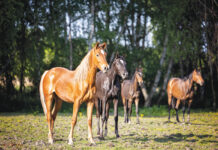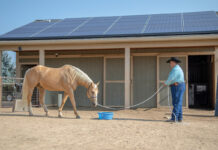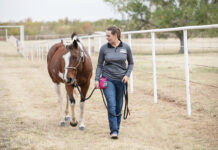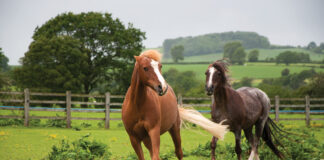Horses are sensitive, but also easy to desensitize. With anything new, a horse will likely react at first. That’s his prey-animal reaction to anything new that could be a threat. Within a split second, horses must decide whether they should flee from the possible threat or relax and conserve energy. Here are some tips on how you can help desensitize your horse.
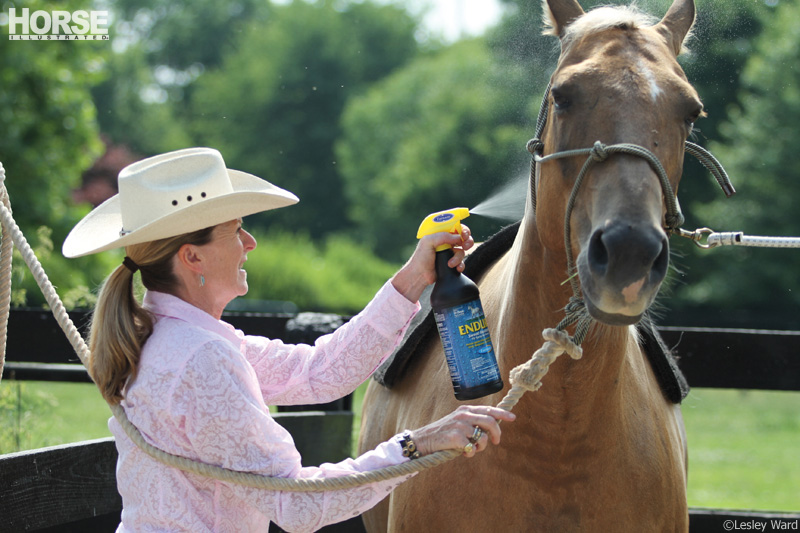
Even a small thing like spray bottles can provide plenty of spook-inducing stimuli. Your horse hears the bottle’s swoosh. He feels the mist on his skin. He smells the spray. All of those sensations are unnatural to your horse—until you teach him that it won’t hurt. He must understand that if he relaxes and accepts it, the stimulus will go away. I like to use the “advance and retreat” technique to teach a horse to accept unfamiliar things. Instead of running away, it activates his investigative behavior.
Advance and Retreat
The first method that can be used for desensitizing your horse can be the advance and retreat method. Using this method, you’ll approach your horse with something new (advance), then stop and turn away when he is calm (retreat). This “advance and retreat process” allows your horse the time he needs to think. He can study what you’re holding, decide how he should react, and receive a reward when he is calm and accepting. The process gives your horse a sense of power over his fears; he learns how to make anything scary go away.
As soon as your horse’s tension begins to dissipate, his fear will convert to a sense of curiosity. A curious horse will follow you when you turn your back and walk away. You may also notice a step toward acceptance when your horse stops moving or running away.
Timing is Everything
When desensitizing your horse, timing is everything. Be sure to watch your entire horse to notice the changes in his tension level. Watch his eyes and facial expressions, his posture, the height of his head, and any turns away. Make sure you advance slowly so that you don’t miss the exact moment that he shows fear.
Keep in mind that all horses react differently. Some are stoic with signs of tension that you can easily miss. Other horses are obvious and react quickly.
Be careful not to remove the stimulus when your horse is reacting negatively. Whatever your horse is doing at the moment you release pressure is what you’re training him to do. If you approach with spray and stop spraying when your horse reacts, you train him to react, not to relax.
Advance & Retreat: A Step-by-Step Guide
- Slowly advance toward your horse while holding the stimulus (the spray bottle, hose, et cetera).
- At the moment your horse tenses, stop but keep holding the stimulus and keep your body posture strong.
- Wait. Once your horse lowers his head or exhales to show his relaxation, remove the stimulus by turning your back and walking away.
- Then repeat. If your timing is good, you’ll be able to approach closer to your horse each time.
Desensitizing Your Horse: Case Study
To get your horse used to spray bottles, outfit him in a rope halter and a lead that is 12 to 15 feet long. For training purposes, use a spray bottle full of water. Work in an area with good footing and without obstacles. You want your horse to be able to safely move away from you.
Stand about 6 feet from your horse and face him. Hold the lead in your left hand and the spray bottle in your right hand. Spray the water to your side or behind you—away from the horse. If your horse tends to be fearful, you can make a spraying sound by saying “shhhh” instead of holding the bottle. You’ll find out if your horse is afraid of the sound alone. If your horse doesn’t react at all when you spray the bottle away from him, it’s time to slowly advance.
Slowly change your aim, triggering the spray bottle toward your horse. As soon as your horse tenses, stop. Keep the pressure of the spray without moving it closer. Wait for your horse to relax, then immediately stop spraying and turn your back.
If your horse reacts and moves away from the spray, move with him, keeping a consistent distance to show him that moving away does not stop the feeling. Movement does not help him. Allow your horse to move in a circle around you until he decides to stop. If he stops circling or stepping to the side, immediately stop and turn your back.
Give your horse a moment to relax and think, then slowly turn and advance again. Look for the first sign of tension, then stop. Hold your ground. Notice any change your horse’s relaxation, then immediately turn away when you see a change. This is the starting point of the desensitizing process for your horse.
If your timing is good, you should be able to advance farther with the stimulus on each approach. However, the horse always determines how far you advance.
Work on one side of your horse at a time instead of switching back and forth. Your horse can only think with one side of his brain at a time. Once your horse has fully accepted the spray on one side, start training on the other.
Remember that your horse sets the pace. If your horse has a lot of fear about spray bottles before you start, it will probably take longer than one session. However, when advance and retreat is done correctly, you can accomplish a lot. Work for about 20 minutes at a time and advance as your horse will allow.
Once you are completely finished with the desensitize process of your horse, you should be able to approach your horse with spray if he is haltered or free. In the beginning, you’ll need to be able to control your horse. If you start the process without a halter, your horse will learn that he can run away from you when he’s scared.
Desensitization happens rapidly. Horses are very fast-learning animals, and when you notice your horse’s tension and change your actions quickly, he’ll learn quickly. If you take your time do your work at each step, it should not take subsequent sessions.
This article originally appeared in the December 2018 issue of Horse Illustrated magazine. Click here to subscribe!

